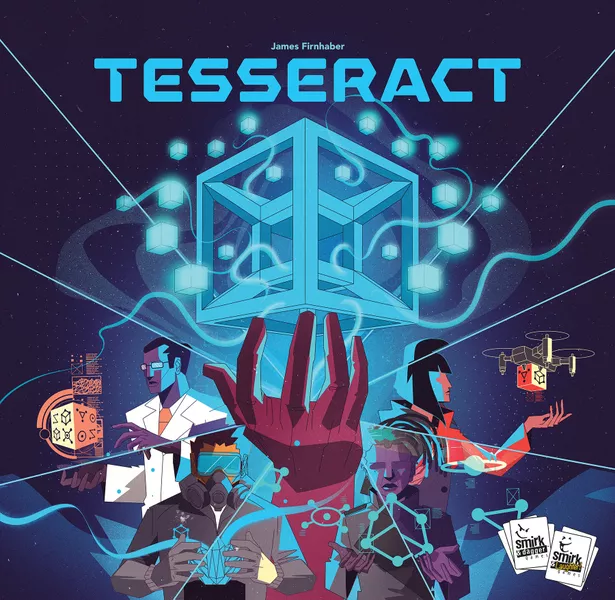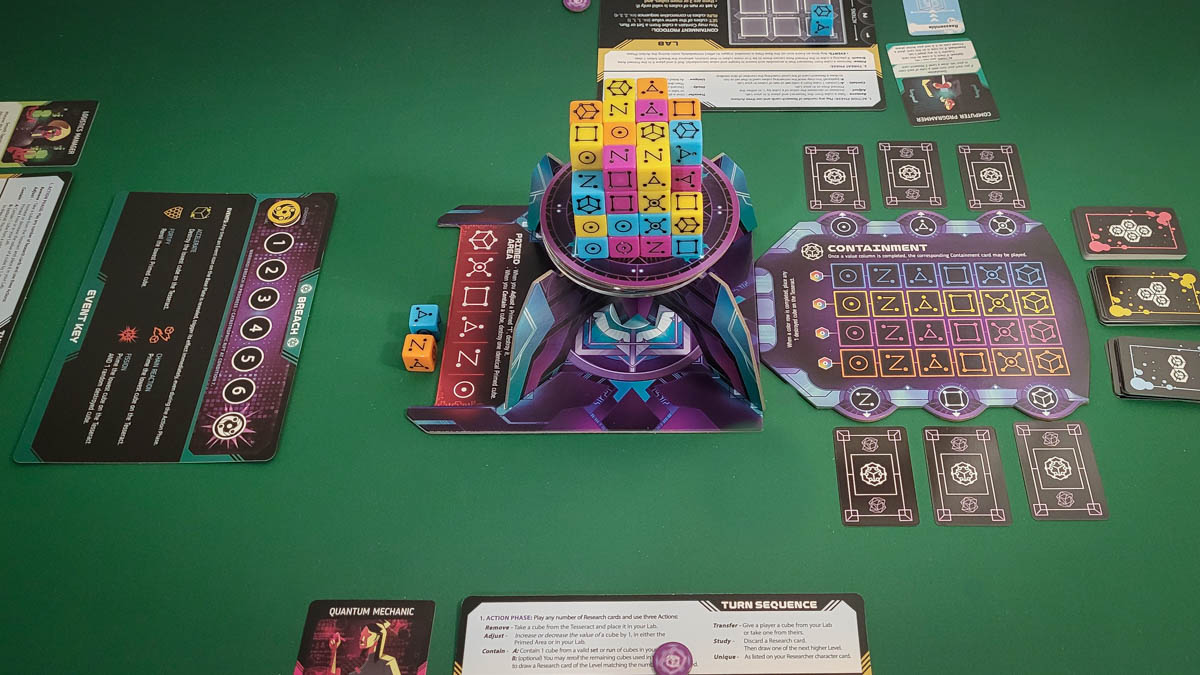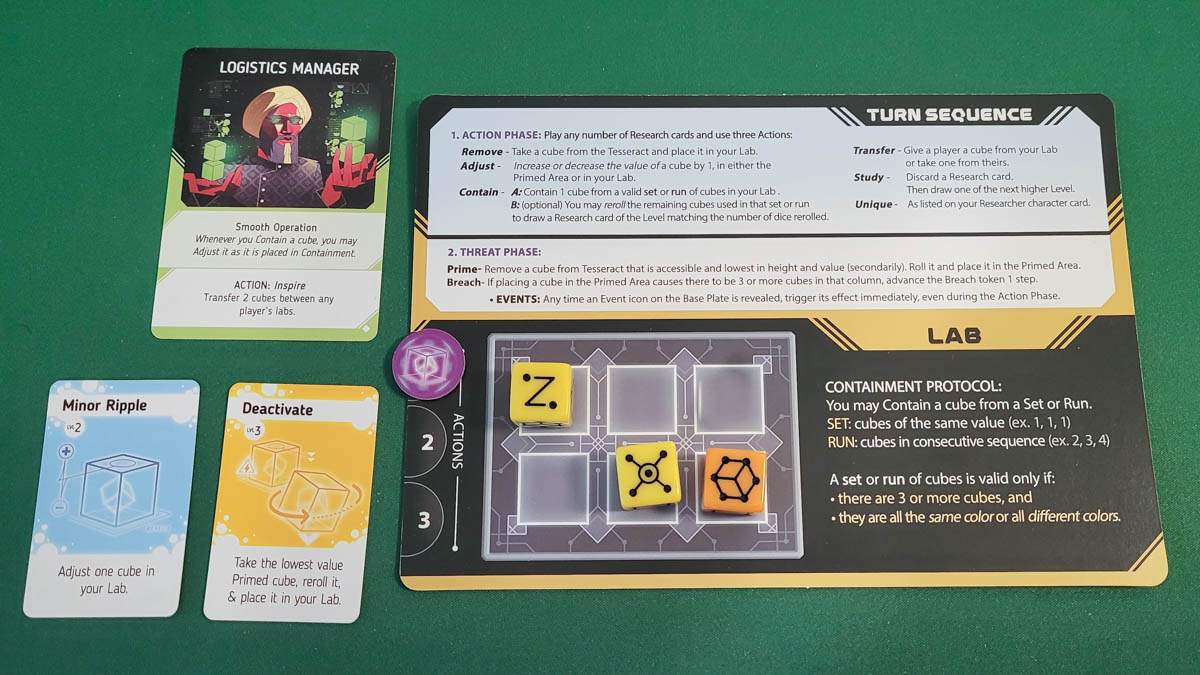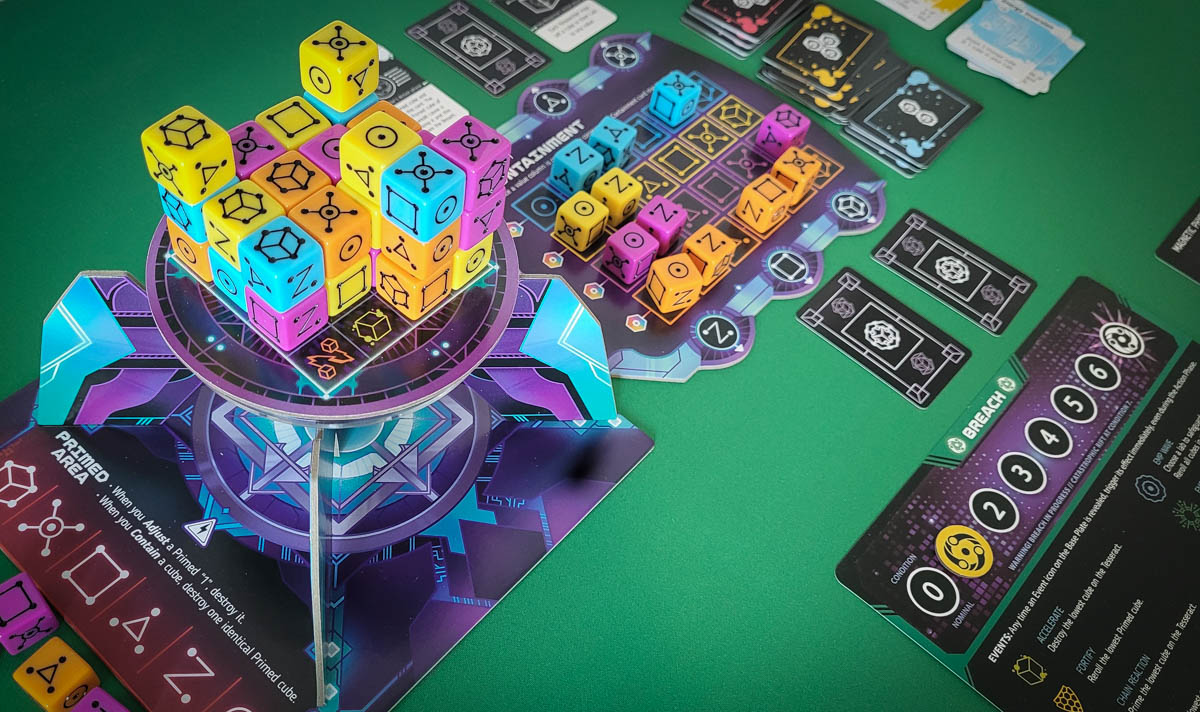Tesseract Review
Year: 2023 | Players: 1-4 | Minutes: 60 | Ages: 14+
This Tesseract review was made after playing the game eight times. We were sent a copy of this game by the publisher in exchange for an honest review.
What is Tesseract?
Tesseract is a dice manipulation puzzle game in which you attempt to shut down an alien artifact before it removes the planet from existence.
Tesseract was designed by James Firnhaber and is published by Smirk & Dagger Games.
Rules Overview
In Tesseract, you and your teammates are scientists attempting to disarm the Tesseract (dice cube) before it destroys the world. You’ll use your scientists’ unique abilities to study it and, hopefully, shut it down.
The focal point of the game is the Tesseract dice cube. At the beginning of each game, you choose a base plate, which determines the difficulty level, and then use the included sleeve to stack all the dice on top of it to form the Tesseract. Dice are removed from it throughout the game by the players and the Tesseract itself.
Tesseract has a classic co-op turn structure. A player takes their actions, bad things happen, and then the next player takes their turn. You take three actions on your turn. The two key actions are the Remove and the Contain actions.
When you do the Remove action, you take a die off the Tesseract and place it on your Lab mat. A removable die is one that has at least three faces showing.
You can do the Contain action when you have three or more dice of the same value or a sequence of numbers (either all the same color or all different). This allows you to move one of those dice to the Containment board, getting you closer to a win and sometimes unlocking new one-off abilities that your team can use. You can also remove a die from the Primed area if it matches the color and value of the die you placed on the Containment board. Afterward, you can optionally reroll your remaining dice and get a Research card. Each Research card gives you a one-off ability that doesn’t cost an action.
The other actions include adjusting dice in your lab or the Primed area, transferring a die to or from someone else’s lab, and using your character’s unique ability. You can also use an action to turn in a Research card to get a new one of a higher level (there are three levels).
During the Threat phase of your turn, the removable die of the lowest level and value is removed from the Tesseract, rolled, and then placed in the Primed area. A breach occurs if there are three or more dice of the same value in the Primed area; when this happens, you move the Breach token forward on the track. Whenever an Event icon is revealed when removing the last die from a column on the Tesseract, the event’s effect happens immediately (always a bad thing).
You’ll win the game if you can put dice in all 24 spaces of the Containment board. You’ll lose if you have a seventh breach or the last die is removed from the Tesseract.
Pros and Cons
Pros
- The Tesseract dice cube works well and it looks great on the table. The flow of the game is similar to other co-op games, but it feels like a unique experience thanks in large part to that dice cube.
- The Contain action is very cool. It gets you closer to winning, which is great, but what I really like about it is that you have multiple decisions to make within the action. Which die will you place on the Containment board? Is there a way for you to remove a die from the Primed area? Should you roll the remaining dice to get a Research card or leave them for future actions? Plenty of options just for that one action.
- I’m a big fan of this Research card system. All of the abilities can be super useful, and I like that you can choose to upgrade your cards or stick with the ones you have, depending on the situation.
- The character and card abilities can be used together to create some sweet combos. There are also plenty of ways to set up combos with and for your teammates.
- The good thing about Tesseract being very puzzly and challenging is that there’s a real sense of accomplishment when your team beats it. Tesseract wins have felt a bit more satisfying than most of the other cooperative games I’ve played in recent years.
- It’s easy to adjust the difficulty. I’m happy at Level 3 for now since I’ve only won two out of six games there so far, but it’s great that I can quickly choose the base plate that works best for the group I’m playing with.
- Tesseract is surprisingly easy to learn and teach. I say “surprisingly” because it looks more complicated than it is.
Cons
- The downside of Tesseract being a puzzle board game with open information is that it can lead to quarterbacking issues for some groups. If one person sees the best plays before others, it could be tempting for them to make the majority of the calls for their team.
- Analysis paralysis can also be a problem for some people and can lead to some long turns/games.
- Anyone with an unsteady hand might have a tough time taking the dice off of the dice cube. It’s not that big of a deal if dice fall since you can just put them back, but I can still see how that might be frustrating for some players.
Final Thoughts
I am definitely going to be keeping Tesseract. I have found it to be a very satisfying experience thanks in large part to the awesome Tesseract cube, but also because each game seems to present a unique challenge depending on the characters you have, the difficulty level, and the order in which the dice move off of the dice cube.
There’s a lot to like about Tesseract and I’ll probably own it for a long time since it seems to have plenty of replay value.
I think most gamers who enjoy puzzly co-ops will get a kick out of Tesseract. The only reason you might want to avoid this one is if you’ve run into quarterbacking issues in the past and you’re trying to stay away from these types of games.
- Update: Tesseract made it onto the Best Puzzle Board Games list!
Tesseract Links
BGG | Amazon | Miniature Market
Thanks for taking the time to read our Tesseract review!
Be sure to also take a look at our Best Cooperative Board Games for Adults and the other board game rankings.
Subscribe to our newsletter if you want more co-op board game content sent right to your inbox!




